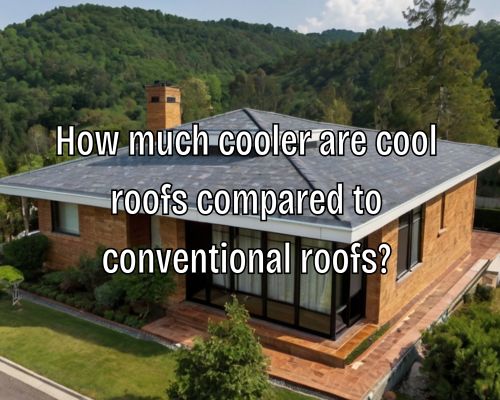Imagine stepping outside on a scorching summer day. The searing heat radiates from every dark surface, intensifying the discomfort. Now picture a solution that can significantly mitigate this heat, not just for your home but for your entire community.
Cool roofs, designed with high solar reflectance, can achieve this by reflecting more sunlight and absorbing less heat than conventional roofs.

Based on Star Roofing Contractors, research indicates that cool roofs can reduce rooftop temperatures by up to 50-60°F (28-33°C) during peak summer weather. This substantial temperature difference helps lower the building’s internal temperature and reduce energy costs.
In hot climates, cool roofs can slash cooling expenses by 5-20%, making them a cost-effective and energy-efficient solution.
Beyond individual savings, cool roofs contribute to broader environmental benefits. They help combat urban heat islands, where cities become significantly warmer than surrounding areas due to heat absorbed by dark surfaces.
By reducing overall heat absorption, cool roofs can play a crucial role in mitigating climate change impacts, creating more sustainable urban environments for future generations.
Fundamentals of Cool Roofs
Cool roofs are designed to reflect more sunlight and absorb less heat compared to conventional roofs. This section will break down what cool roofs are, the materials and technologies used, their solar reflectance and thermal emittance capabilities, and a comparison with conventional roofing options.
What Is a Cool Roof?
A cool roof is designed to maintain a lower temperature than a traditional dark roof by reflecting more sunlight and absorbing less heat. These roofs achieve their cooling effects through materials and coatings that have high solar reflectance and thermal emittance properties.
The main benefit of a cool roof is reduced energy use by minimizing the need for air conditioning. This can lead to significant energy savings, particularly in hot climates.
Materials and Technologies
Cool roofs can be made from various materials such as metal shingles, white roofing products, and asphalt shingles with cool-colored granules.
Some effective technologies include single-ply membranes, built-up roofing systems, and special reflective coatings.
These materials and technologies either contain cool-colored pigments that efficiently reflect sunlight or have a high solar reflectance index (SRI). This index measures the roof’s ability to reject solar heat, combining both solar reflectance and thermal emittance.
Solar Reflectance and Thermal Emittance
Solar reflectance is the ability of a roof to reflect the sun’s energy. It is measured on a scale from 0 to 1, where values closer to 1 indicate higher reflectance.
Thermal emittance, also measured on a scale from 0 to 1, represents the roof’s ability to release absorbed heat.
White roofs and roofs with high reflectance coatings typically have higher albedo, reflecting a substantial portion of incoming solar radiation. A high solar reflectance index (SRI) value indicates the roof’s efficiency in staying cool by reflecting sunlight and radiating absorbed heat.
Comparing Cool Roofs to Conventional Roofs
Compared to conventional dark roofs, cool roofs can remain significantly cooler—by up to 50-60°F (28-33°C) under the same conditions.
Traditional dark roofs can reach temperatures of 150°F (66°C) or more in sunny conditions.
Cool roofs can reduce the annual air conditioning energy use of a building by up to 15%. This makes them effective for lowering energy bills, reducing carbon emissions, and providing more comfortable interior spaces.
Cool roofs are beneficial for both new construction and existing buildings looking to improve energy efficiency.
Impact and Benefits of Cool Roofs
Cool roofs offer significant advantages by reducing energy usage, mitigating urban heat, and providing environmental and health benefits. These benefits make cool roofs a compelling choice for both residential and commercial buildings.
Energy Efficiency and Cost Savings
Cool roofs reflect more sunlight and absorb less heat compared to dark roofs. This high solar reflectance reduces rooftop temperatures by up to 55°F.
As a result, buildings with cool roofs experience lower indoor temperatures, decreasing the need for air conditioning.
In both residential and commercial buildings, this can lead to energy savings of 5-20% on cooling costs, depending on the climate zone.
Using materials such as cool asphalt shingles, concrete tiles, or single-ply membranes, you can improve a building’s energy efficiency.
Implementing a cool roof can also extend the lifespan of your roofing materials since they undergo less thermal stress. These factors contribute to reduced energy consumption and lower energy costs, making cool roofs a cost-effective investment.
For installation work and details, just have Star Roofing Contractors for a better and quality work.
Mitigating Urban Heat Islands
The urban heat island effect occurs when urban areas experience higher temperatures than their rural surroundings. Dark and non-reflective roofs contribute significantly to this phenomenon.
Cool roofs help mitigate this effect by reflecting sunlight and reducing heat absorption, thereby lowering air temperatures in urban areas.
By installing cool roofs on a large scale, cities can achieve lower overall urban temperatures, leading to decreased cooling energy use and less strain on energy grids.
The reduction in air temperature also improves outdoor comfort and can significantly reduce the risk of heat-related illnesses in densely populated areas. This makes cool roofs a vital tool in addressing urban heat issues.
Environmental and Health Benefits
Cool roofs play a crucial role in reducing greenhouse gas emissions. They lower energy usage, especially for air conditioning. As a result, cool roofs decrease the associated pollution and carbon footprint.
This reduction is beneficial for combating climate change and improving urban air quality.
In addition, cooler indoor environments help maintain indoor comfort and reduce dependence on mechanical ventilation systems. This has co-benefits for human health.
Lower indoor temperatures and improved air quality enhance overall well-being. Incorporating cool roofs into building designs also aligns with environmental guidelines.
It can qualify you for various incentives from energy programs. By helping reduce pollution and enhance public health, cool roofs contribute positively to both the environment and society.